Farmers in the Texas High Plains have a new budgeting tool available with the release of the 2016 High Plains Crop Profitability Analyzer, said Dr. Steve Amosson, Texas A&M AgriLife Extension Service economist in Amarillo.
“We wanted to create a decision aid that assists irrigated operators in making management decisions on the optimal crop mix for their land,” Amosson said. “And while High Plains’ budgets are used, the flexibility of this program makes it easily usable in other areas of the country.”
The tool was created by a team of AgriLife Extension and Texas A&M AgriLife Research specialists with a producer advisory committee. The 2016 High Plains Crop Profitability Analyzer can be downloaded for free at: http://amarillo.tamu.edu/.
The irrigated crops available for analysis are: alfalfa, canola, corn, corn silage, cotton, peanuts, sorghum, sorghum seed, sorghum silage, sorghum sudangrass, soybeans, sunflowers, triticale and wheat. Dryland crops include: canola, cotton, sorghum, sorghum sudangrass, sunflowers and wheat.
“This powerful spreadsheet program contains the 2016 projected sprinkler-irrigated and dryland crop budgets for the Texas High Plains,” Amosson said. “This is an extremely flexible tool that can assist producers in evaluating their cropping choices for the upcoming year.”
He said the budget cost estimates are averages and producers using it can and will need to modify the budgets and change input costs and yields to fit their operations.
The spreadsheet contains four sections where analysis is performed: enterprise budget, breakeven, comparative and irrigation, Amosson said.
“The enterprise budgets not only provide a measure of crop profitability, but also allow for checking the ‘equitability’ of a crop-share lease agreement,” he said. “In the breakeven section, a sensitivity analysis is performed that varies yield and calculates the various prices that would be required to cover out-of-pocket and total costs for each of the crops.”
Amosson said the comparative section provides the expected revenue, out-of-pocket and total costs for each of the crops. The irrigation section allows a producer to identify the water available and any water-use restrictions that apply.
“Based on all that information and the crop budgets, the amount of land and profitability is calculated for each of the crops and presented both numerically and graphically,” he said.
“Another interesting feature is that you can ‘toggle on’ or ‘toggle off’ crops, so you can limit the analysis to only crops you are interested in growing,” Amosson said.
The development of this tool was made possible with a grant provided by the Texas Corn Producers Board.

